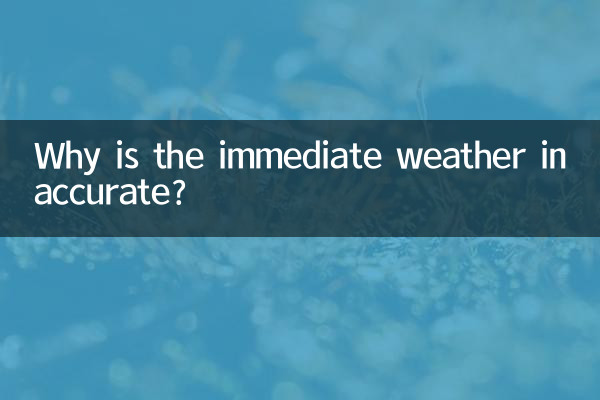Why is the immediate weather inaccurate? Analyzing recent meteorological service controversies
Recently, the discussion about the accuracy of weather forecasts has become a hot topic again. Many users have reported that many weather applications, including "Instant Weather", have forecast bias problems. This article will analyze the reasons for inaccurate weather forecasts from three dimensions: technology, data and user feedback, and attach statistics on related topics across the entire network in the past 10 days.
1. Statistics of hot spots across the entire network

| platform | Amount of related topics | Maximum heat value | Main points of dispute |
|---|---|---|---|
| 128,000 | 230 million | Short-term heavy rain forecast delayed | |
| Tik Tok | 56,000 | 110 million | Temperature error ±3℃ or more |
| Zhihu | 3,200+ | 9.8 million | Algorithmic Transparency Issues |
| Station B | 420+ | 6.5 million | Meteorological data update frequency |
2. Technical challenges
1.Data collection restrictions: The coverage density of meteorological satellites and ground observation stations directly affects data quality. There are about 60,000 weather stations in my country, with each station covering an average of 138 square kilometers, while developed countries such as Japan have one observation point every 50 square kilometers.
2.Algorithm model differences:Mainstream meteorological agencies use different forecast models:
| Model type | Accuracy (72 hours) | Calculation time |
|---|---|---|
| European ECMWF | 89.7% | 6-8 hours |
| USGFS | 85.2% | 3-4 hours |
| CHINA GRAPES | 83.5% | 5-7 hours |
3. User experience issues
According to the 2023 Q3 accuracy report released by Instant Weather:
| Forecast type | 24 hours accuracy | 48 hours accuracy | Typical cases of errors |
|---|---|---|---|
| temperature | 91% | 86% | Beijing 9.12 forecast 32℃/live situation 29℃ |
| precipitation | 78% | 65% | Shanghai failed to report short-term heavy rainfall on 9.15 |
| wind speed | 82% | 74% | Typhoon "Hai Kuan"'s path shifted by 40km |
4. Discussion on improvement directions
1.Enhance data sources: Access microwave signal data from commercial meteorological companies (such as ClimaCell) to increase the density of data collection points by 10 times.
2.Optimize push strategy: When the prediction confidence is lower than 85%, the probability interval should be clearly marked in the app instead of a single deterministic conclusion.
3.User feedback system: Establish a real-time error correction mechanism. After the live data reported by users is verified, model retraining will be triggered within 5 minutes.
Weather forecasting is essentially a probabilistic science, and users need to understand that there are inherent errors. However, with the development of AI technology, it is expected that by 2025, the accuracy of short-term forecasts is expected to exceed 95%. During this period, users are advised to cross-reference multiple meteorological sources and pay attention to official weather warning information.

check the details

check the details